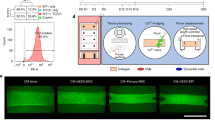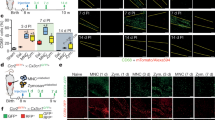Abstract
Clinical and basic studies of cell-based myocardial therapy have proceeded at a rapid pace. Cell therapy could lead to successful cardiac regeneration or repair by any of three general mechanisms: differentiation of the administered cells into all of the cellular constituents of the heart; release of factors capable of paracrine signaling from the administered cells; and fusion of the administered cells with the existing constituents of the heart. Here, we argue that a fourth general mechanism could be operative: stimulation of endogenous repair by injected cells, which and might cause the regeneration of stem cell niches. In a porcine model of myocardial infarction, allogeneic mesenchymal stem cells stimulated substantial improvement in the ejection fraction, reduction of infarct size, and the growth of a rim of new cardiac tissue in the region in which the mesenchymal stem cells were injected. These effects occurred in the absence of definitive cardiac myocyte differentiation. After myocardial infarction, porcine hearts exhibit evidence of cardiac myocytes that have entered the cell cycle, neovascularization, and reduced levels of apoptosis. These data, in addition to new insights regarding the presence of endogenous cardiac stem cells, strongly support the concept that the heart could contain stem cell niches. Effective cell therapy could lead to restoration of these niches through multifaceted cell–cell interactions.
Key Points
-
Several mechanisms could explain the efficacy of cell-based therapies to repair cardiac injury
-
The mechanisms include cell differentiation and engraftment, and release of paracrine factors
-
Bone-marrow-derived mesenchymal stem cells stimulate myocardial recovery following injury, but evidence for differentiation is lacking
-
The heart contains endogenous stem cells that can be extracted and cultured ex vivo
-
The heart probably contains stem cell niches, which might represent structural and functional units mediating cardiac repair
This is a preview of subscription content, access via your institution
Access options
Subscribe to this journal
Receive 12 print issues and online access
$209.00 per year
only $17.42 per issue
Buy this article
- Purchase on Springer Link
- Instant access to full article PDF
Prices may be subject to local taxes which are calculated during checkout



Similar content being viewed by others
References
Boyle AJ et al. (2006) Is stem cell therapy ready for patients? Stem cell therapy for cardiac repair—Ready for the next step. Circulation 114: 339–352
Kudo M et al. (2003) Implantation of bone marrow stem cells reduces the infarction and fibrosis in ischemic mouse heart. J Mol Cell Cardiol 35: 1113–1119
Mangi AA et al. (2003) Mesenchymal stem cells modified with Akt prevent remodeling and restore performance of infarcted hearts. Nat Med 9: 1195–1201
Amado LC et al. (2005) Cardiac repair with intramyocardial injection of allogeneic mesenchymal stem cells after myocardial infarction. Proc Natl Acad Sci USA 102: 11474–11479
Assmus B et al. (2006) Transcoronary transplantation of progenitor cells after myocardial infarction. New Engl J Med 355: 1222–1232
Schachinger V et al. (2006) Intracoronary bone marrow-derived progenitor cells in acute myocardial infarction. New Engl J Med 355: 1210–1221
Pittenger MF et al. (1999) Multilineage potential of adult human mesenchymal stem cells. Science 284: 143–147
Assmus B et al. (2002) Transplantation of Progenitor Cells and Regeneration Enhancement in Acute Myocardial Infarction (TOPCARE-AMI). Circulation 106: 3009–3017
Kamihata H et al. (2001) Implantation of bone marrow mononuclear cells into ischemic myocardium enhances collateral perfusion and regional function via side supply of angioblasts, angiogenic ligands, and cytokines. Circulation 104: 1046–1052
Schachinger V et al. (2004) Transplantation of progenitor cells and regeneration enhancement in acute myocardial infarction. Final one-year results of the TOPCARE-AMI Trial. J Am Coll Cardiol 44: 1690–1699
Strauer BE et al. (2002) Repair of infarcted myocardium by autologous intracoronary mononuclear bone marrow cell transplantation in humans. Circulation 106: 1913–1918
Wollert KC et al. (2004) Intracoronary autologous bone-marrow cell transfer after myocardial infarction: the BOOST randomised controlled clinical trial. Lancet 364: 141–148
Meyer GP et al. (2006) Intracoronary bone marrow cell transfer after myocardial infarction: eighteen months' follow-up data from the randomized, controlled BOOST (BOne marrOw transfer to enhance ST-elevation infarct regeneration) trial. Circulation 113: 1287–1294
Perin EC et al. (2003) Transendocardial, autologous bone marrow cell transplantation for severe, chronic ischemic heart failure. Circulation 107: 2294–2302
Strauer BE et al. (2005) Regeneration of human infarcted heart muscle by intracoronary autologous bone marrow cell transplantation in chronic coronary artery disease: the IACT Study. J Am Coll Cardiol 46: 1651–1658
Zimmet JM and Hare JM (2005) Emerging role for bone marrow derived mesenchymal stem cells in myocardial regenerative therapy. Basic Res Cardiol 100: 471–481
Amado LC et al. (2006) Multimodality noninvasive imaging demonstrates in vivo cardiac regeneration after mesenchymal stem cell therapy. J Am Coll Cardiol 48: 2116–2124
Chen SL et al. (2004) Effect on left ventricular function of intracoronary transplantation of autologous bone marrow mesenchymal stem cell in patients with acute myocardial infarction. Am J Cardiol 94: 92–95
Davis ME et al. (2006) Local myocardial insulin-like growth factor 1 (IGF-1) delivery with biotinylated peptide nanofibers improves cell therapy for myocardial infarction. Proc Natl Acad Sci USA 103: 8155–8160
Tang YL et al. (2005) Improved graft mesenchymal stem cell survival in ischemic heart with a hypoxia-regulated heme oxygenase-1 vector. J Am Coll Cardiol 46: 1339–1350
Davani S et al. (2003) Mesenchymal progenitor cells differentiate into an endothelial phenotype, enhance vascular density, and improve heart function in a rat cellular cardiomyoplasty model. Circulation 108 (Suppl 1): II253–II258
Shake JG et al. (2002) Mesenchymal stem cell implantation in a swine myocardial infarct model: engraftment and functional effects. Ann Thorac Surg 73: 1919–1925
Silva GV et al. (2005) Mesenchymal stem cells differentiate into an endothelial phenotype, enhance vascular density, and improve heart function in a canine chronic ischemia model. Circulation 111: 150–156
Gnecchi M et al. (2005) Paracrine action accounts for marked protection of ischemic heart by Akt-modified mesenchymal stem cells. Nat Med 11: 367–368
Scholzen T and Gerdes J (2000) The Ki-67 protein: From the known and the unknown. J Cell Physiol 182: 311–322
Condorelli G et al. (2001) Cardiomyocytes induce endothelial cells to trans-differentiate into cardiac muscle: implications for myocardium regeneration. Proc Natl Acad Sci USA 98: 10733–10738
Olivares EL et al. (2004) Bone marrow stromal cells improve cardiac performance in healed infarcted rat hearts. Am J Physiol Heart Circ Physiol 287: H464–470
Kajstura J et al. (2004) Bone marrow cells differentiate in cardiac cell lineages after infarction independently of cell fusion. Circ Res 97: 127–137
Laugwitz KL et al. (2005) Postnatal isl1+ cardioblasts enter fully differentiated cardiomyocyte lineages. Nature 433: 647–653
Oh H et al. (2003) Cardiac progenitor cells from adult myocardium: homing, differentiation, and fusion after infarction. Proc Natl Acad Sci USA 100: 12313–12318
Nygren JM et al. (2004) Bone marrow-derived hematopoietic cells generate cardiomyocytes at a low frequency through cell fusion, but not transdifferentiation. Nat Med 10: 494–501
Orlic D et al. (2001) Bone marrow cells regenerate infarcted myocardium. Nature 410: 701–705
Orlic D et al. (2001) Mobilized bone marrow cells repair the infarcted heart, improving function and survival. Proc Natl Acad Sci USA 98: 10344–10349
Noiseux N et al. (2006) Mesenchymal stem cells overexpressing Akt dramatically repair infarcted myocardium and improve cardiac function despite infrequent cellular fusion or differentiation. Mol Ther, in press
Beltrami AP et al. (2003) Adult cardiac stem cells are multipotent and support myocardial regeneration. Cell 114: 763–776
Messina E et al. (2004) Isolation and expansion of adult cardiac stem cells from human and murine heart. Circ Res 95: 911–921
Beltrami AP et al. (2001) Evidence that human cardiac myocytes divide after myocardial infarction. New Engl J Med 344: 1750–1757
Urbanek K et al. (2003) Intense myocyte formation from cardiac stem cells in human cardiac hypertrophy. Proc Natl Acad Sci USA 100: 10440–10445
Urbanek K et al. (2005) Myocardial regeneration by activation of multipotent cardiac stem cells in ischemic heart failure. Proc Natl Acad Sci USA 102: 8692–8697
Mouquet F et al. (2005) Restoration of cardiac progenitor cells after myocardial infarction by self-proliferation and selective homing of bone marrow-derived stem cells. Circ Res 97: 1090–1092
Anversa P et al. (2006) Life and death of cardiac stem cells: a paradigm shift in cardiac biology. Circulation 113: 1451–1463
Martin CM et al. (2004) Persistent expression of the ATP-binding cassette transporter, Abcg2, identifies cardiac SP cells in the developing and adult heart. Dev Biol 265: 262–275
Linke A et al. (2005) Stem cells in the dog heart are self-renewing, clonogenic, and multipotent and regenerate infarcted myocardium, improving cardiac function. Proc Natl Acad Sci USA 102: 8966–8971
Limana F et al. (2005) Exogenous high-mobility group box 1 protein induces myocardial regeneration after infarction via enhanced cardiac c-kit(+) cell proliferation and differentiation. Circ Res 97: E73–E83
Moore KA and Lemischka IR (2006) Stem cells and their niches. Science 311: 1880–1885
Yin T and Li LH (2006) The stem cell niches in bone. J Clin Invest 116: 1195–1201
Urbanek K et al. (2006) Stem cell niches in the adult mouse heart. Proc Natl Acad Sci USA 103: 9226–9231
Acknowledgements
This work was supported by grants from the Johns Hopkins Specialized Center for Cell-Based Therapy, the Johns Hopkins University School of Medicine Institute for Cell Engineering (ICE), and the Donald W Reynolds Foundation and National Institutes for Health (NIH).
Author information
Authors and Affiliations
Corresponding author
Ethics declarations
Competing interests
Joshua M Hare has received research grants from Osiris Therapeutics Inc. R Mazhari declared she has no competing interests.
Rights and permissions
About this article
Cite this article
Mazhari, R., Hare, J. Mechanisms of action of mesenchymal stem cells in cardiac repair: potential influences on the cardiac stem cell niche. Nat Rev Cardiol 4 (Suppl 1), S21–S26 (2007). https://doi.org/10.1038/ncpcardio0770
Received:
Accepted:
Issue Date:
DOI: https://doi.org/10.1038/ncpcardio0770
This article is cited by
-
Emerging Trends in Mesenchymal Stem Cells Applications for Cardiac Regenerative Therapy: Current Status and Advances
Stem Cell Reviews and Reports (2022)
-
Microenvironmental changes induced by placenta-derived mesenchymal stem cells restore ovarian function in ovariectomized rats via activation of the PI3K-FOXO3 pathway
Stem Cell Research & Therapy (2020)
-
Priming approaches to improve the efficacy of mesenchymal stromal cell-based therapies
Stem Cell Research & Therapy (2019)
-
Pre-Conditioning Stem Cells in a Biomimetic Environment for Enhanced Cardiac Tissue Repair: In Vitro and In Vivo Analysis
Cellular and Molecular Bioengineering (2018)
-
Effect of low-level laser-treated mesenchymal stem cells on myocardial infarction
Lasers in Medical Science (2017)



